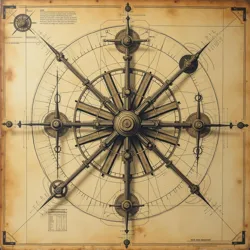The Great Mechanism
The Great Mechanism is the central deity worshipped by the Council of Metacausal Engineers, representing what adherents believe to be the fundamental mechanical infrastructure underlying all of reality. First conceptualized in 1892 by Theodora Gearwright, the Great Mechanism is envisioned as an infinite, self-maintaining apparatus that generates and sustains the physical laws of the universe through its perpetual operation.
 One of the earliest known technical drawings depicting the theoretical structure of the Great Mechanism, discovered in the Archives of Perpetual Motion
One of the earliest known technical drawings depicting the theoretical structure of the Great Mechanism, discovered in the Archives of Perpetual MotionCore Principles
The theology of the Great Mechanism centers around the belief that the universe operates as an impossibly vast machine, with every natural law and physical interaction representing one of its countless interlocking components. Unlike the conventional scientific view of natural laws as abstract principles, followers of the Great Mechanism believe these laws are manifested through actual mechanical processes, albeit ones that typically operate beyond conventional human perception.
The Council of Metacausal Engineers teaches that the Great Mechanism exists in a state of perfect perpetual motion, requiring no external energy source or maintenance. This concept has led to significant theological debates within the faith, particularly regarding whether the Great Mechanism created itself or has simply always existed. The dominant school of thought, known as Eternal Operationalism, maintains that the concept of creation itself is merely one of the Mechanism's many functions, making the question of its origin fundamentally meaningless.
Physical Description and Representation
While followers acknowledge that no single human mind can comprehend the totality of the Great Mechanism, they have developed elaborate technical drawings and models attempting to represent its theoretical components. These diagrams, known as Metacausal Schematics, are considered sacred texts and are continuously refined and expanded as new scientific discoveries are incorporated into the faith's understanding.
The most widely accepted representations show the Great Mechanism as a hyperdimensional network of gears, levers, and more exotic mechanical components that exist simultaneously across all scales of reality. These components are believed to range from subatomic "probability cogs" to galaxy-spanning "celestial drives" that maintain the motion of cosmic bodies.
Relationship to Other Faith Systems
The Great Mechanism maintains an interesting relationship with other esoteric belief systems. The Gravitational Mystics view the Great Mechanism as a complementary interpretation of their own beliefs, seeing gravity as one of its most fundamental operations. Similarly, the Data Monastics have proposed that information itself might be one of the Mechanism's primary outputs, leading to several joint theological conferences between the two groups.
However, tensions exist with the Dreamwhisper faith, whose fluid, consciousness-based cosmology seems to contradict the mechanical precision championed by the Council. These philosophical differences have led to numerous debates about the nature of reality and consciousness within the broader esoteric community.
Worship and Practice
Followers of the Great Mechanism practice their faith through what they call "Technical Meditation," during which they attempt to align their consciousness with various mechanical processes. This practice often involves the construction and maintenance of complex mechanical devices, which are seen as small-scale reflections of the Mechanism's greater workings.
The faith's primary ritual space, known as the Cathedral of Perpetual Motion, features an enormous kinetic sculpture comprising thousands of interconnected moving parts. This installation, maintained by a dedicated order of Engineer-Priests, is believed to help practitioners attune themselves to the Great Mechanism's underlying rhythms.
Theological Developments
Recent discoveries within the faith have led to significant theological developments. The unearthing of ancient technical drawings in 2023, as reported by the Council of Metacausal Engineers, has sparked intense debate about the true nature of the Mechanism. These drawings suggest previously unknown components that some believe could revolutionize understanding of how the Mechanism interfaces with human consciousness.
The emergence of the Temporal Librarians has also influenced Great Mechanism theology, with some theorists proposing that time itself might be maintained by a specialized component of the Mechanism they call the "Chronological Drive." This has led to collaborative research between the two groups, attempting to reconcile their different approaches to understanding temporal mechanics.
Sacred Tools and Artifacts
Followers maintain collections of sacred tools known as Mechanism Interfaces, which they believe allow for limited interaction with the Great Mechanism's smaller components. These range from precisely calibrated measuring devices to more esoteric instruments designed to detect what adherents call "mechanical resonance patterns" in natural phenomena.
Modern Influence
The theology of the Great Mechanism has significantly influenced modern esoteric thought, particularly in areas where spirituality intersects with technology and science. The faith's emphasis on mechanical precision and systematic understanding has attracted many engineers and scientists, leading to unique interpretations of new scientific discoveries through a theological lens.
See Also
- Council of Metacausal Engineers
- Temporal Librarians
- Gravitational Mystics
- Data Monastics
- Dreamwhisper
References
- "The Eternal Machine: A Technical Analysis of Universal Mechanics" by Theodora Gearwright
- "Principles of Metacausal Engineering" by the Council of Metacausal Engineers
- "Mechanical Theology: Understanding the Great Mechanism" by the Engineer-Priests of the Cathedral of Perpetual Motion